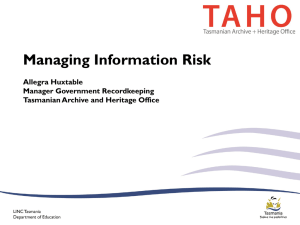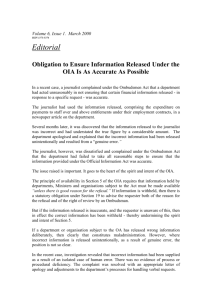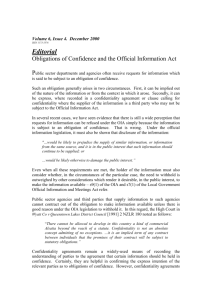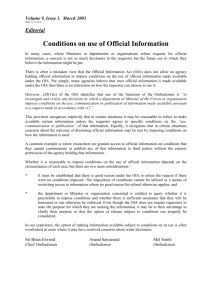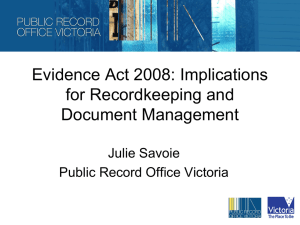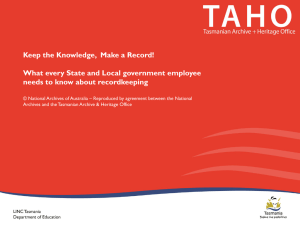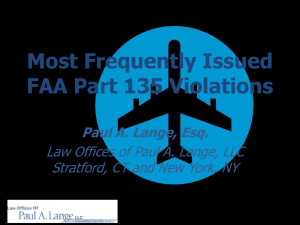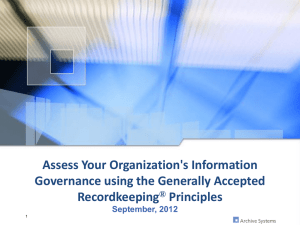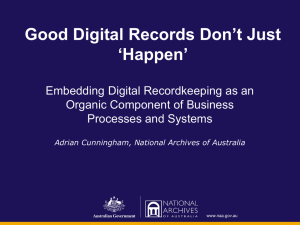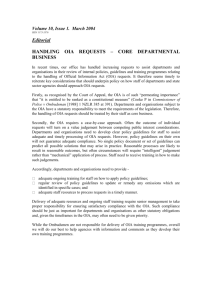DOC - Office of the Ombudsman
advertisement
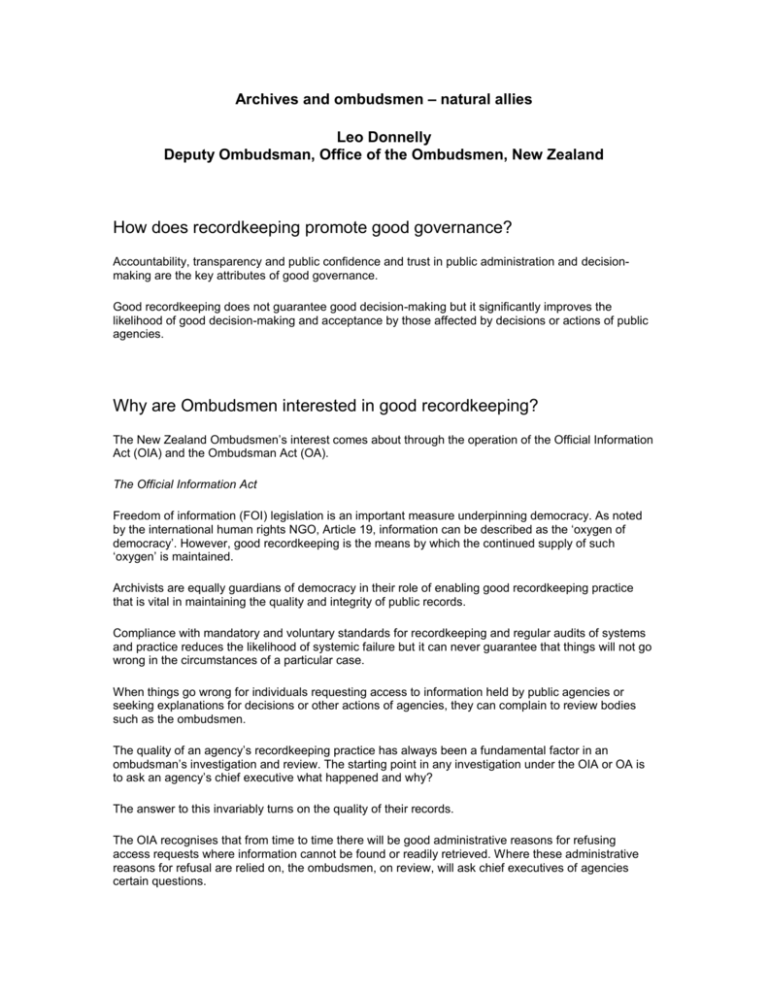
Archives and ombudsmen – natural allies Leo Donnelly Deputy Ombudsman, Office of the Ombudsmen, New Zealand How does recordkeeping promote good governance? Accountability, transparency and public confidence and trust in public administration and decisionmaking are the key attributes of good governance. Good recordkeeping does not guarantee good decision-making but it significantly improves the likelihood of good decision-making and acceptance by those affected by decisions or actions of public agencies. Why are Ombudsmen interested in good recordkeeping? The New Zealand Ombudsmen’s interest comes about through the operation of the Official Information Act (OIA) and the Ombudsman Act (OA). The Official Information Act Freedom of information (FOI) legislation is an important measure underpinning democracy. As noted by the international human rights NGO, Article 19, information can be described as the ‘oxygen of democracy’. However, good recordkeeping is the means by which the continued supply of such ‘oxygen’ is maintained. Archivists are equally guardians of democracy in their role of enabling good recordkeeping practice that is vital in maintaining the quality and integrity of public records. Compliance with mandatory and voluntary standards for recordkeeping and regular audits of systems and practice reduces the likelihood of systemic failure but it can never guarantee that things will not go wrong in the circumstances of a particular case. When things go wrong for individuals requesting access to information held by public agencies or seeking explanations for decisions or other actions of agencies, they can complain to review bodies such as the ombudsmen. The quality of an agency’s recordkeeping practice has always been a fundamental factor in an ombudsman’s investigation and review. The starting point in any investigation under the OIA or OA is to ask an agency’s chief executive what happened and why? The answer to this invariably turns on the quality of their records. The OIA recognises that from time to time there will be good administrative reasons for refusing access requests where information cannot be found or readily retrieved. Where these administrative reasons for refusal are relied on, the ombudsmen, on review, will ask chief executives of agencies certain questions. How a chief executive answers these questions will turn on the quality of the agency’s records, recordkeeping practice and systems. If a chief executive cannot respond adequately because of an agency’s failure to create or maintain records that it should have created or maintained, this opens the prospect of an OA investigation that the failure amounts to maladministration. The Ombudsmen Act The Ombudsman Act essentially provides an avenue for independent and impartial investigation of complaints about maladministration so that the public can have greater trust and confidence in public sector decision-making. The fundamental role of an ombudsman in investigating complaints is to establish the truth of a matter – what happened and why. Establishing the truth begins and ends with the quality and integrity of public records. How does an alliance with archives arise? In essence, the ombudsmen are the ambulance at the bottom of the cliff. They are usually the first of the accountability agencies to be engaged ‘when things go wrong’ for an individual. The investigation of what happened and why, often identifies a ‘gap in the fence’ at the top of the cliff but it is not always easy for ombudsmen to get to that ‘gap’ to fix it. Where the ‘gap’ has arisen because of a failure by an agency to create and maintain in accessible form full and accurate records, archives are the experts at the top of the cliff that the ombudsmen can turn to as an ally in fixing the ‘gap’ to help prevent future systemic failure. The New Zealand experience – case study This concerns the outcome of the Ombudsman’s investigation of the police refusal to make available the final investigation report of the Cave Creek tragedy. The background to the Cave Creek tragedy was as follows: On 17 April 1995, 17 members of a party of students from a Polytechnic Outdoor Recreation course and a Department of Conservation (DOC) field centre manager crowded onto a viewing platform high above Cave Creek in Paparoa National Park, New Zealand. The platform collapsed and all 18 people fell 30 metres. 13 students and the DOC manager died. The other 4 students suffered serous injury. The viewing platform had been built in 1994 by DOC so that visitors to the national park could look down a 40 metre chasm to see the headwaters of Cave Creek come out from an underground cave system. Following investigations by the police, the department and a special commission of inquiry ordered by the government of the day, it was found that: The plans for the platform had been designed and approved by people who did not have engineering or design qualifications. The onsite construction of the platform base had been carried out by a working party of DOC staff members. None of the group working on the platform were qualified builders or engineers. The platform had been built and then flown in to Cave Creek by helicopter to be put in place, but the plans for the installation of the platform were not taken to the site, and so were not followed. The bolts which were supposed to tie the platform to the steps were taken to the site, but the drill was left behind, so nails were used instead. When the concrete steps to the platform were poured some time later they were not secured properly to the platform. This concrete was supposed to act as a counterweight for the platform to help hold it in place. Steel which was supposed to tie the platform to the counterweight had disappeared, and no other steel was ordered or used. A commission of inquiry found that the Department of Conservation had acted illegally and negligently in constructing the platform, and that there had been a series of mistakes that together had led to the collapse of the Cave Creek platform. It also pointed out that the department had not been given enough resources to do its job properly. Because of this, projects were carried out on limited budgets, ‘making do’. Compensation of $2.6 million was paid out to the victims families. The project had not met the requirements of the Building Act, which was being extended to cover government departments at the time the platform was being planned and built. There was no building consent for the platform. Signs stating the maximum number of people to go on the platform at a time had not been put in place. There were no prosecutions as a result of the deaths, but the Department’s West Coast regional conservator resigned after the commission of inquiry report came out. The Minister of Conservation, Denis Marshall, later resigned in May 1996. The Chief Executive of the Department resigned and has never held office in the public sector since. Accountability and transparency were substantially met by these outcomes but for one parent of a victim of the tragedy, there was one fundamental accountability document that he still needed to see before he could move on. This was the original police investigation report that allegedly concluded that certain individuals should have been prosecuted. The parent requested access to the report under the OIA. Inexplicably, neither the original police report nor any copy could be found. The police refused the request on the basis that the document requested under the OIA could not be found. Reluctantly, despite significant efforts to locate the report or a copy, the then Ombudsman and now Governor-General Anand Satyanand had to accept that nothing more could be done under the OIA. This is a classic case of a citizen losing confidence and trust in public administration unnecessarily. Good recordkeeping would clearly have ensured that such an important document was copied and retained. If the same case arose today, following the enactment of the Public Records Act 2005, the options open to an ombudsman are different. An ombudsman could: find that the failure to have established sound recordkeeping systems and practice to ensure retention of such critical investigation records was maladministration recommend that the Chief Archivist conduct an ‘audit’ of the agency’s recordkeeping systems, using the powers of inspection and direction to report to the Chief Archivist under the Public Records Act, with a view to identifying any changes in practice or wider systems that would prevent such maladministration in future following consultation with the Chief Archivist as to the necessity and practicality of such changes, recommend to the agency, its minister and ultimately Parliament that certain changes should be implemented in the public interest. Conclusion Although the connection between quality recordkeeping and good governance is not always obvious, the New Zealand Ombudsmen’s experience over 46 years is that they are inextricably linked. You can’t have one without the other. Without systems and practices to ensure good recordkeeping, agencies will be compromised in their ability to respond to legitimate requests for information or explanations about actions taken or not taken. Equally, poor recordkeeping undermines what should otherwise be a fundamental check and balance on decision making and the exercise of discretionary powers by public agencies. Accountability, transparency and public trust and confidence in ‘the system’ will suffer. However, we all know this. Ombudsmen and archives are natural allies but without coordinated action, the potential benefit to the citizen, society and good governance generally is undermined. The real trick is to do something meaningful about it now. In the words of Will Rogers: Even if you are on the right track, you will get run over if you just sit there.
